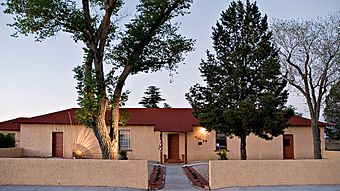Building 98 facts for kids
|
Building 98, Fort D.A. Russell
|
|
|
U.S. Historic district
Contributing property |
|

Building 98
|
|
| Location | W. Bonnie St., Marfa, Texas |
|---|---|
| Area | 2.3 acres (0.93 ha) |
| Built | 1920 |
| Part of | Fort D.A. Russell Historic District (ID06001152) |
| NRHP reference No. | 04000100 |
Quick facts for kids Significant dates |
|
| Added to NRHP | February 25, 2004 |
| Designated CP | December 14, 2006 |
Building 98 at Fort D. A. Russell is a special historic building near Marfa, Texas. It used to be a place for army officers to live and relax. It also had a big ballroom for parties. This building was part of Fort David A. Russell and was used by the US Army from 1911 to 1946. Today, it is managed by the International Woman's Foundation. It is also famous for its unique murals painted by German prisoners of war during World War II.
Contents
Amazing Murals Inside
Building 98 is home to some very special paintings called murals. These murals cover over 3,048 square feet of wall space. They are found in what used to be the fort's dining room and library. Two German prisoners of war named Hans Jürgen Press and Robert Humpel painted them in 1945.
Hans Jürgen Press was an artist and writer. He was a glider pilot during the war. After the war, he left Building 98 in 1945. While he was there, he also painted two watercolors of people from West Texas. One showed a person doing a Spanish dance, and the other showed someone playing a Spanish guitar. These murals are a unique part of history and show Marfa's long connection to art.
A Look Back at History
Building 98 has a rich history that began in 1911. At that time, the United States Cavalry used the building. It was a place for officers who were not married to live. It also served as a fun place for officers from West Point during World War I and the Mexican Revolution.
The fort itself was built to keep local ranches and towns safe. This was important during dangerous times along the Texas and Mexico border. Building 98 was also near the main parade grounds. It even housed the fort's officer's mess, which had a full-time chef and a large dining room.
In 1949, the historic fort was sold to J. Alfred Roosevelt. He was a grandson of Emlen Roosevelt. The International Woman's Foundation later helped get Fort D. A. Russell listed on the National Register of Historic Places. They also helped list it with the Texas Historical Commission. This was a dream of J. Alfred Roosevelt, who had lived at the fort.
Since 2002, the International Woman's Foundation has run an artist-in-residency program. They also manage the Camp Marfa fort museum. Mona Blocker Garcia started the foundation in 2002. Her goal was to create a place for mature women artists and to preserve the important history of Fort D. A. Russell.
Bringing Building 98 Back to Life
The International Woman's Foundation has been working hard to restore Building 98. They want to make it look just like it did originally. They helped get Fort D. A. Russell added to both the National Register of Historic Places and the Texas state historical society register.
Big restoration projects started in 2002. They completely replaced the roof and fixed the outside walls. They also focused on the floors, furniture, and ceilings. They made sure to keep the original features. This helped fix damage that happened after 1949 and after the Great Depression.
Today, the restored Building 98 is a museum. It is open to the public, and you can take a guided tour. Building 98 is one of Marfa's most important historic places. Its rich history has been brought back to life. Preserving this old army camp helps future generations understand Texas's important role in the past.
Art Galleries and Exhibitions
Building 98 also has art galleries called Studio 98. Artists who are part of the artist-in-residence program can show their work here. The foundation hosts special events and receptions in the historic officers' club. These events happen every year and are announced through media.
One important exhibition was a large show of works by Wilhelmina Weber Furlong. This show was held in the grand ballroom. It featured over 75 artworks by this early American modernist artist that had never been seen before. The exhibit also displayed some of her personal belongings, including her Victorian easel. This event was part of the foundation's ten-year anniversary celebration in October 2012.
See Also
- German prisoners of war in the United States
- List of World War II prisoner-of-war camps in the United States
- National Register of Historic Places listings in Presidio County, Texas



